Northwood meadows timber harvest
December 8, 2017 Update
The timber harvest at Northwood Meadows was completed on December 7th 2017. The project was designed to preserve and sustain the values of forest ecology and wildlife habitat while providing locally sourced wood products for our families and homes. Although a freshly operated timber harvest may have a harsh visual appeal to some, within the next few years’ new vegetation will regenerate and occupy the disturbed site providing valuable growth, wildlife food sources and great viewing opportunities. We appreciate park user’s patience with sharing the main road during the projects implementation
For more information on this this project and timber harvesting in State Parks and State Forests, contact Regional Forester, Scott Rolfe at 603-227-8741 or Project Forester, Samuel Taylor at 603-227-8735.
November 9, 2017 Update
The timber harvest at Northwood Meadows has begun, and will continue for several weeks. During this time, Dashingdown Road and the park entrance will be shared with log trucks. If possible, please avoid the active harvest area indicated on the map (see trail detour marker). Over the course of the operation, a feller buncher will cut the trees marked for harvest, and skidders will drag them back to the log yard where they will be processed into their various products. Sawlogs will be piled to await transport, and low grade material will be chipped. Please maintain a safe distance from logging equipment at all times in order to avoid falling trees, flying debris, etc. Do not assume an operator can see you – the equipment being utilized has large blind spots that may obstruct their view. If you must approach a machine, wait until the operator has acknowledged you and has throttled down and exited the machine before approaching.
For more information on this this project and timber harvesting in State Parks and State Forests, contact Regional Forester, Scott Rolfe at 603-227-8741 or Project Forester, Samuel Taylor at 603-227-8735.
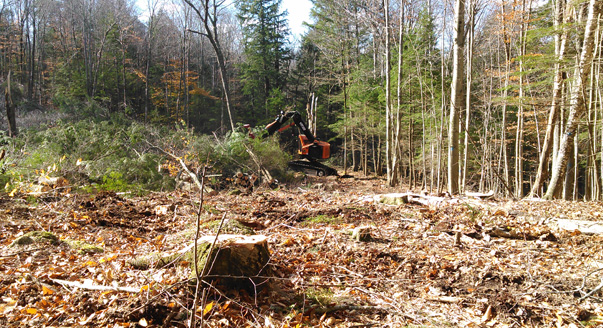
Feller Buncher operating in group cut at Northwood Meadows.
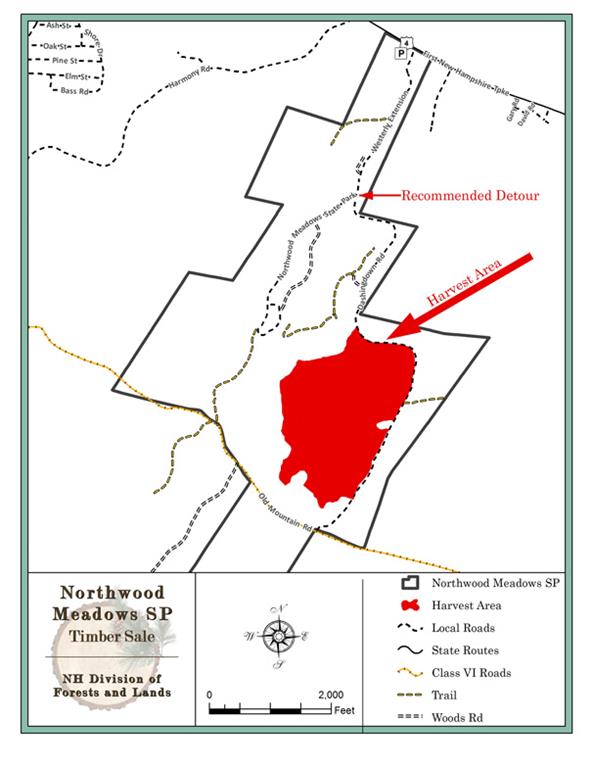
October 3, 2017 Update
Layout and marking on the Northwood Meadows State Park timber sale (P1-623) have been completed. Over several days in May and June, locations for group cuts were selected based on a combination of factors, such as areas of mature timber, areas with disease or other health issues, spacing from other groups, topography, and distance from wetlands and streams. The boundaries of these groups were first delineated by hanging orange flagging tape on trees around each perimeter. Skid roads (trails along which the felled trees are dragged back to the log yard) were then laid out by hanging blue flagging tape periodically to connect the groups, taking care to minimize the number of stream crossings necessary.
Once the layout was complete, a small crew of foresters worked together in late June and early July to mark the sale. All trees to be cut were marked with blue paint according to the basic timber product represented by a particular tree. A horizontal slash represents a sawlog to be used for dimensional or finish lumber, whereas a dot specifies a low-grade product such as pulpwood, firewood, or chipwood. Trees to be retained within group cuts are marked with a W, indicating a wildlife tree. These are generally larger trees with cavities or other qualities that make them particularly valuable for wildlife. Skid trails are marked with vertical stripes or an X along the centerline of the trail. As the sale is marked, each painted tree is tallied by species, diameter, product, and merchantable height to use in estimating volumes of timber for sale at public bid. The next step in the process is a field tour for prospective bidders, called the “showing”. This was held on August 10th. Following the showing, interested parties have two weeks to submit a bid, after which the harvest is awarded to the highest bidder in good standing.
A public informational field tour was held on Saturday, August 19th.
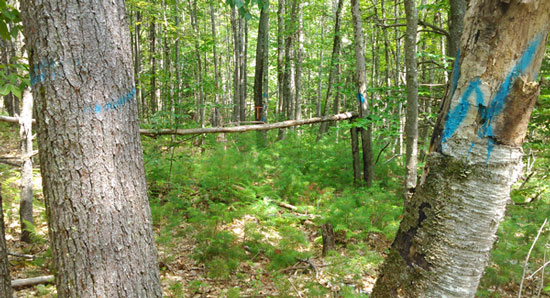
Existing white pine regeneration that will be released by this harvest.
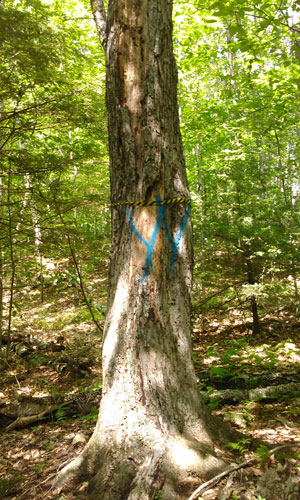
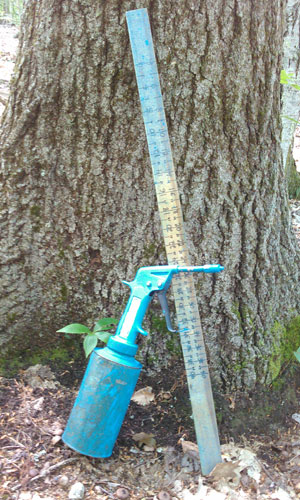
(1) Example of a marked wildlife tree. Believe it or not, this tree is still alive! Marking gun and Biltmore stick. (2) The marking gun is used to apply paint, while the Biltmore stick is used to estimate diameters in 2-inch classes.
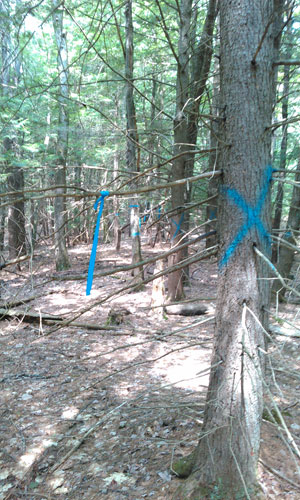
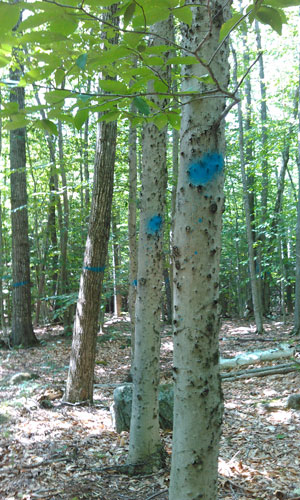
(3) Marked skid trail. (4) Beech trees infected with beech bark disease. A common ailment in our forests, this fungus causes cankers that weaken the tree, often leading to “beech snap” when wind breaks the trunk of the tree.
May 2017 Update
The Division of Forest and Lands is in the planning stages to harvest timber and improve wildlife habitat on 81 acres at Northwood Meadows State Park during the late summer and fall of 2017. This project is located in the area west of Dashingdown Road.
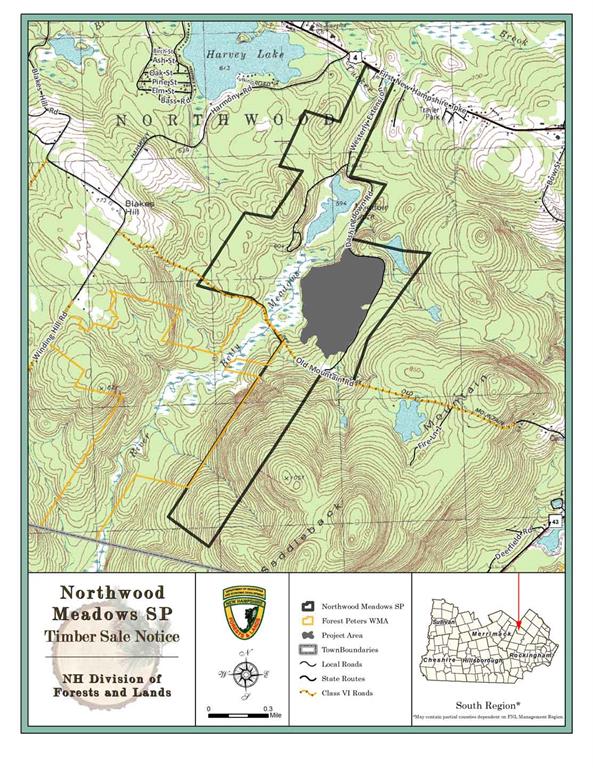
When a harvest on state lands is being considered, there are several steps that must occur – this process is far from hasty. First, a forester from the Division of Forests and Lands performs what is called a “prescription cruise.” In this process, the forester measures a sample of trees throughout the woods, while also making note of the health and quality of the forest, sensitive features on the landscape such as wetlands, streams, and cellar holes, and wildlife habitat features such as large down logs and trees with cavities (holes where an animal could nest). During and after the prescription cruise, a plan is developed for how best to treat the forest. This depends on many factors, including health, age, and form of the trees, soil characteristics, insect and disease considerations, and wildlife values. Possible treatments range from selecting individual trees for harvest, to large clearcuts, to leaving the woods alone. Once a treatment is developed, it is presented for review and comment by several state agencies, including the Fish and Game Department, Division of Parks and Recreation, Natural Heritage Bureau, Trails Bureau, and the Department of Cultural Resources. Following this review process, the forester implements the “layout” of the sale, choosing how best to arrange skid roads and harvest areas to minimize impacts on streams and wetlands, while having the most benefit for timber and wildlife goals.
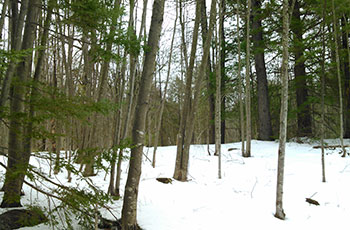
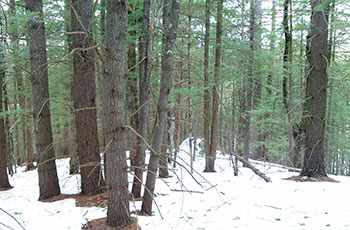
(1) Small stand of sapling-pole sized trees, approximately 40 years old. Trees this size/age make up around 19% of the entire property. Trees smaller and younger than this only occur on about 1% of Northwood Meadows State Park, and represent an important habitat that is lacking on this landscape. (2) Mature eastern white pine stand with hemlock understory. Group selection can promote softwood species such as these for wildlife benefits and timber production.
In this timber sale, groups of trees ¼ - 2 acres in size will be harvested, totaling approximately 19 acres. The forest canopy gaps created by this harvest will allow light to reach the forest floor, helping to establish the seedling trees that will grow into the next generation of forest. Not only is this an important management tool for regenerating certain tree species, but the shrubby habitat structure that develops in the years following such a harvest provides food and cover for a suite of wildlife species.
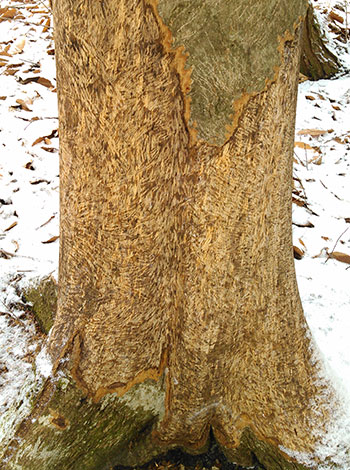
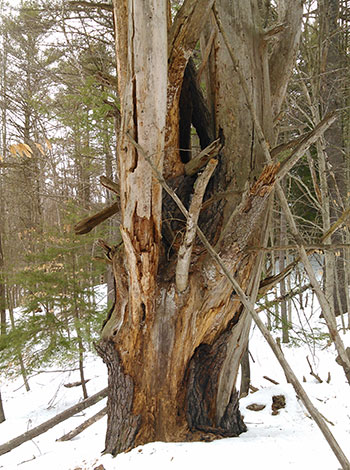
(3) Porcupine marks on American beech tree. This is one of the more common wildlife signs at Northwood Meadows. (4) Large snag tree in the project area. Features like this are valuable for wildlife and will be retained whenever possible.
This technique, called “group selection,” results in a patchwork of size and age classes across the project area, which serves two main functions. First, groups are selected in a manner that ensures that we will not be harvesting more than can be sustainably grown over time. Second, the structural diversity resulting from these cuts is valuable for wildlife – essentially, if the forest is uniformly composed of older age classes, fewer species can utilize the habitat. Additionally, the area between groups will be thinned, removing some trees to give the remaining trees more space, light, and nutrients to improve their growth and make them less susceptible to insect and disease issues.
For more information on this this project and timber harvesting in State Parks and State Forests, contact Regional Forester, Scott Rolfe at 603-227-8741 or Project Forester, Samuel Taylor at 603-227-8735.